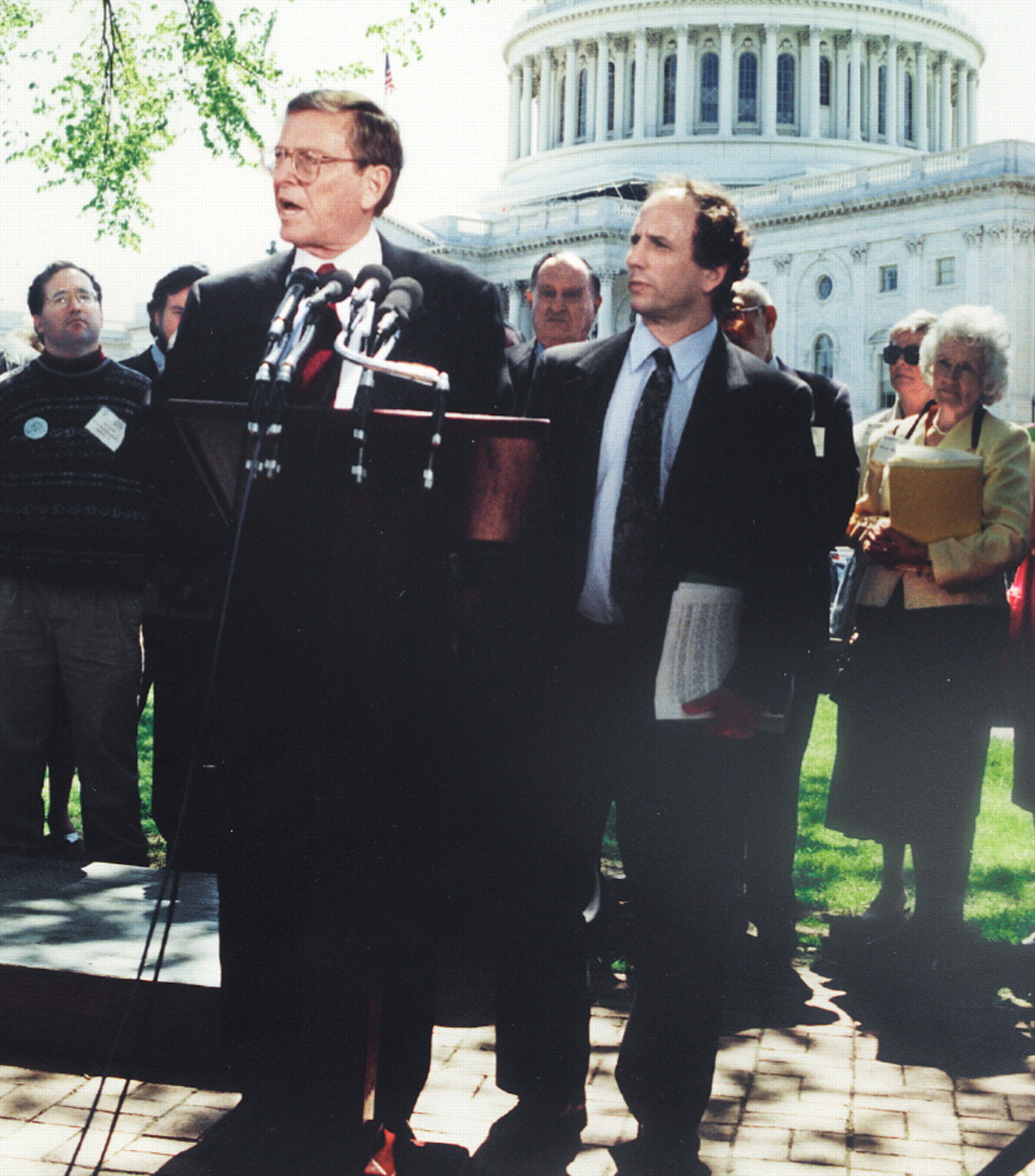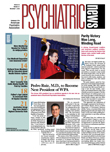APA's latest and highest-profile legislative victory—the enactment of a landmark federal mental health insurance parity law—came in a quick and little-opposed Congressional vote last month. That outcome wasn't as smooth and sudden as it seemed to many outside the mental health field: it was the hard-earned reward for three decades of relentless work by APA leaders, members, and staff in combination with other mental health advocates.
The parity measure, passed by Congress as part of the massive financial industry rescue package (HR 1424), requires health plans that offer mental health coverage to have the same benefits, copayments, and treatment limits as other types of health care (see
New Federal Parity Law Detailed). The law, which will give 113 million people across the country the right to nondiscriminatory mental health coverage, goes into effect one year after enactment or on January 1, 2010, for most calendar-year plans.
“The apparently easy culmination of the struggle to pass parity was deceptive,” said Nicholas Meyers, director of APA's Department of Government Relations (DGR), “In fact, it was kind of like a duck gliding along smoothly and calmly on the surface of the pond, while paddling furiously underwater to stay afloat and keep moving.”
APA helped form the coalitions that ultimately pushed Congress to pass the measure and was at the table during critical negotiations to overcome the opposition of insurance and business representatives to parity.
Among the first to push for a federal parity measure was Jay Cutler, J.D., an effort he began soon after coming to APA as head of DGR in the late 1970s. (Cutler, who died in 2005, was previously minority counsel and staff director for the Senate Health and Human Resources Committee.) A critical component of APA's coalition-building efforts was Cutler's decision, with the full support of then-Medical Director Melvin Sabshin, M.D., to focus the Association's legislative resources on measures that directly benefited patients, not just psychiatrists.
Cutler's initial success was in improving Medicare's limited mental health benefit. “Jay Cutler deserves a tremendous amount of the credit. I remember him and [DGR lobbyist] Ellen Smith lobbying me while I was working on the Hill in the 1980s to lift Medicare's $250 cap on outpatient mental health treatment,” Meyers said. “At the time, APA, with Jay, was the only mental health professional association lobbying for patients, not just its members' own economic interests. That was a big factor in why I wanted to work at APA.”
Cutler's and other APA advocates' efforts began to pay off with the introduction of the first federal parity bill in 1992. The bill that was enacted four years later mandated parity insurance coverage between mental and physical disorders in lifetime and annual dollar limits.
This victory was achieved through the help of what was the first of many coalitions APA helped form or joined over the succeeding years to get parity legislation through Congress: the Coalition for Fairness in Mental Illness Coverage. Among its members were the AMA and the National Alliance on Mental Illness (NAMI). “This has always been a collaborative effort,” Meyers said.
Though limited in scope, the law paved the way for many states to enact their own more generous parity laws in the following years, according to Meyers. The law also was significant because it was among the first to change aspects of the federal Employee Retirement Income Security Act (ERISA), which governs the self-funded plans that cover 82 million individuals and are not subject to state parity laws, thus protecting them from state coverage mandates.
Among the earliest and strongest congressional supporters of parity were Sens. Paul Wellstone (D-Minn.) and Pete Domenici (R-N.M.), under whose leadership Congress passed the first federal mental health parity law in 1996. Domenici and Wellstone both knew personally of the devastating impact—financial as well as emotional—on families with a mentally ill relative and reached across the aisle to promote parity.
Wellstone died in a plane crash while he was campaigning for reelection in 2002. His efforts and the continuing support of Domenici in recent years led sponsors to title the parity bill that Congress passed last month the Paul Wellstone and Pete Domenici Mental Health Parity and Addiction Equity Act of 2008.
It was clear after passage of the 1996 parity law that a stepped-up lobbying effort was needed by APA. Part of that effort was the creation of APAPAC. The long-term effort of that group, funded by APA member and staff contributions, to form bipartisan alliances was critical in moving parity through the long legislative process as well as the final focused push for Congress to enact it, said John Wernert, M.D., APAPAC chair.
“APAPAC gave us the access and relationships that allowed us in the 11th hour when it mattered to address our friends on both sides of the aisle,” Wernert said.
The new law was crafted from several parity measures introduced since 1996, which included two versions—one in the House and one in the Senate—with important differences drafted in 2007. Although generally similar to a House bill sponsored by Rep. Patrick Kennedy (D-R.I.), the Senate bill emerged from months of exhaustive negotiations between parity advocates—including APA—and business and insurance lobbies with different goals. Some parity supporters disparaged the Senate version in favor of the more generous House bill, while APA strongly supported both.
“To get there, it was necessary for both the House and Senate to pass the strongest bills they could,” Meyers said. “We viewed [the different versions] as an absolutely necessary part of the process of getting [parity] to the strongest compromise.”
Congressional negotiators eventually compromised on differences in the two bills last summer after parity leaders—including Sens. Edward Kennedy (D-Mass.) and Domenici and Reps. Pete Stark (D-Calif.) and Jim Ramstad (R-Minn.)—continually pushed to keep the measure on Congress's radar.
“We owe them a tremendous debt of gratitude,” Meyers said.
The final and most powerful key to parity's passage, Meyers said, was the broad, sustained support of APAPAC and other APA members who repeatedly contacted their members of Congress to urge support for parity
Regulatory Discussions Next
Continued APA member involvement will be needed as federal regulators scramble to decide how to implement the broadly worded parity legislation before January 1, 2010. Member psychiatrists will be asked in the coming months to provide comments on proposed regulations.
Among the critical issues that regulators must decide is how to implement the law's provision allowing employers to opt out of providing parity mental health coverage if it becomes too costly, according to Meyers. “We still have a lot of work to do,” he said.
Future legislation may be necessary if follow-up studies determine that companies are dropping mental health coverage altogether or sharply limiting the psychiatric or substance use conditions they cover.
“I hope our members will experience this landmark achievement as giving them the energy to follow through and make parity real,” said APA President Nada Stotland, M.D., in an interview.
Lessons Inform Future Battles
But APA leaders are also taking a little time to savor the significant victory of parity enactment, which followed another successful legislative effort over the summer to equalize Medicare's copay for treatment of mental illness to that for treatment of other medical conditions and thus eliminate the longstanding disparity between the two.
The recent legislative accomplishments stem in no small part from APA's efforts to educate the public as well as members of Congress about mental illness. Stotland made a public-education campaign about parity the leading priority of APA's Joint Commission on Public Affairs when she first chaired it in 1995.
“It took a long time to get Congress to learn that mental illnesses are no-fault illnesses and that people who have them deserve help,” said Carolyn Robinowitz, M.D., immediate past president of APA.
In addition to the need to educate legislators and the public, the parity battle taught APA leaders that the use of coalitions and partnerships is critical.
“You don't get what you want just because your cause is right and just,” said APA Medical Director James H. Scully Jr., M.D. “You have to do the hard work of building coalitions and getting allies.”
Wernert also emphasized that future legislative accomplishments will depend on broadening APA member support of APAPAC beyond the 6 percent who now contribute to it.
“It takes an ongoing effort,” he said. “You can't just throw money at the problem when a crisis arises.”
More information on APA's advocacy efforts, including the new parity law, can be accessed at<www.psych.org/MainMenu/AdvocacyGovernmentRelations/GovernmentRelations.aspx>.▪

